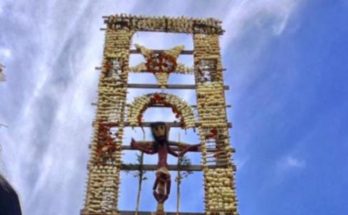By Jose Arturo Morales Tirado
The turning point for the cultural tradition of San Miguel de Allende at the dawn of the Chichimeca war was the arrival and foundation of the first settlement promoted by the newly dominant Spaniards and their indigenous conquest allies (mostly Otomi from Jilotepec (today, in the state of Mexico) of the old domain of Tlaxcala, plus Zapotecs from Oaxaca. The event is, of course, a historical fact (with many facets or aspects) but, at the same time, an increasingly mythologized event of racial and cultural blending (mestizaje).
Over the years, with the encouragement of decision-makers and political, economic, and even religious leaders, we have confused the process of syncretism—the combining of different beliefs—as a simple, straightforward fusion of two ancient cultural traditions, the European and the Mesoamerican. However, this is far removed from syncretism’s profound, complex reality. Because in reality, the marvel that represents the complex, multiethnic society of San Miguel de Allende and the frontier region of the Tierra Adentro (Mexico’s interior highlands) is actually a living mosaic of the diverse perceptions and interpretations of ourselves in our local and global environment in terms of time, space, and circumstances relative to ecology, society, governance, economy, and culture.
Humanity has used at least three general methods to try and make sense of our different perceptions of the environment: 1) reason and observation, whereby we more or less conceptualize reality through argumentation, philosophy, science, and technology; 2) worldview or cosmovision, where we see and interpret the world and ourselves based on reason and observation plus the sum of beliefs that allow us to analyze and recognize reality based on our own existence; and 3) religion, or the perception of existence through myths and historical facts transformed into dogmas of faith and their derived rituals.
Before moving on to current examples of syncretism expressed in myths, rituals, or characters of our immense natural and cultural wealth in the Tierra Adentro region, it seems to me a wonder that in our territory, thanks to tolerance and collective memory, reason and observation, worldview and cosmovision (mainly Mesoamerican), and religion (mainly Judeo-Christian) naturally coexist. That is to say that in San Miguel de Allende and its surrounding region, one can find cultural expressions with a high degree of syncretism (not fusion but coexistence) among the ancient Mesoamerican, Aridoamerican, Greco-Latin, Judeo-Christian (Catholic, Lutheran, Evangelical, Adventist, Anglican, Mormon), Moorish, Jewish (Sephardim and Ashkenazi), and, in the last 50 years, Muslim, Buddhist, agnostic, and atheist traditions. Without a doubt, our small but multiethnic Sanmiguelense society lives in an atmosphere of respect and tolerance, valuing every individual, including the natural coexistence of vulnerable minority and marginalized populations.
As an example of this, we can observe the construction of facades, dating from the period of the viceregency of New Spain in the former San Miguel el Grande, of Catholic temples with multiple icons with at least two readings of symbols and meanings. Alfredo López Austin, in “The Characters of the Myth” (Mexican Archeology, Special Edition No. 92, August 2020), said that from when the Mesoamerican human beings first began to communicate with their environment, they spoke and communicated with the stones, water, air and wind, with the trees and herbs, insects, reptiles, birds and mammals; they looked to the horizon and the sky, talked and communicated with the hills, the mountains, the volcanoes, their peaks and their ports, plus the infinite cosmos in the celestial vault. Through this dialogue with the environment, the civilization of the human was generated,
including the multiple spoken and unspoken languages, written and of forms and symbols both ephemeral and constant, where little by little but continually, they began to establish symbolic expressions of nature or concepts (ideas made symbols) to form the languages of the local multicultural identity and, thus, the multiethnic sense of belonging. This might be seen in a facade of a Catholic temple with the faces of felines, icons of the feminine duality, rain, humidity, fertility, water flowing in springs, or in contrast, symbols of the masculine duality, dry, warm, of the daytime, and wild.
These are wonders of our extraordinary, complex multiethnic community in the syncretic coexistence of observation and reason, worldviews and cosmovision, and religions, of our rich and complex community and its authentic, unique, unrepeatable local cultural tradition, the wonder of our Frontera Tierra Adentro.




